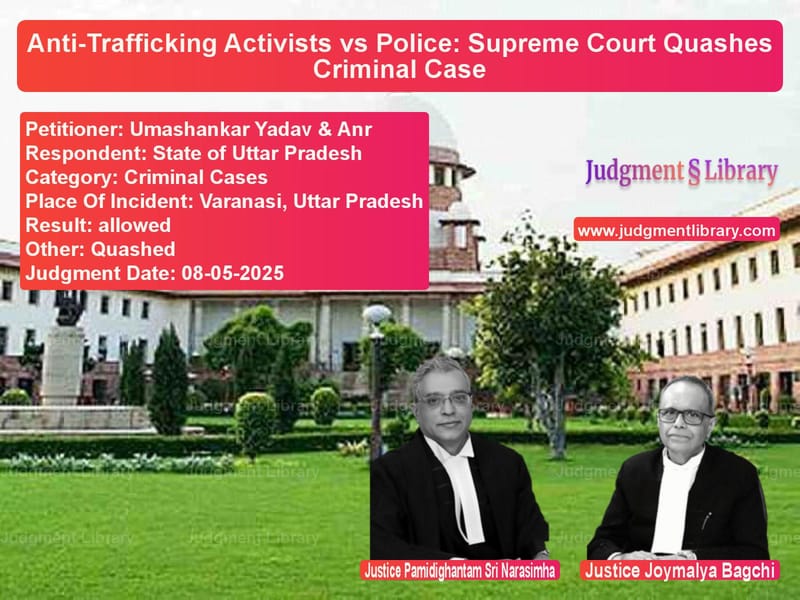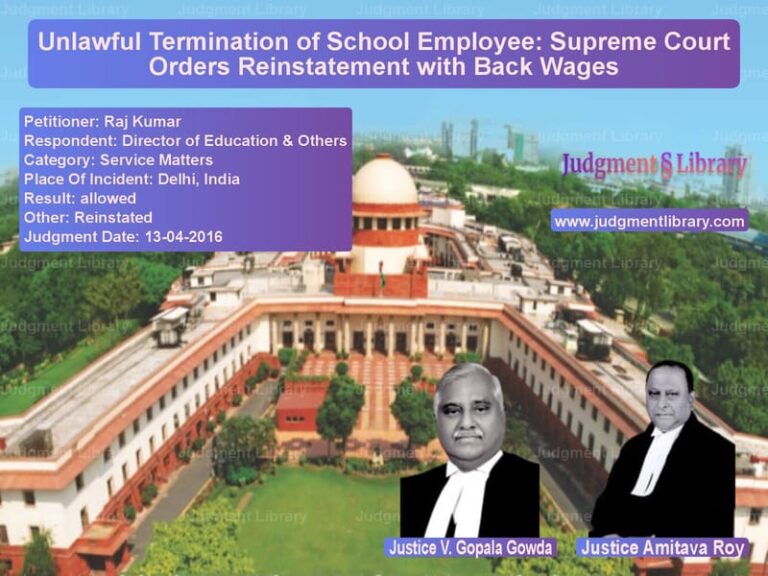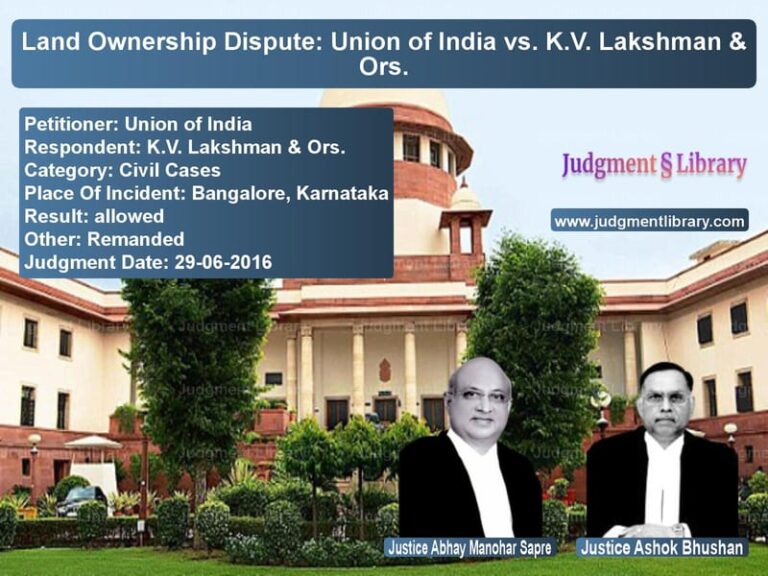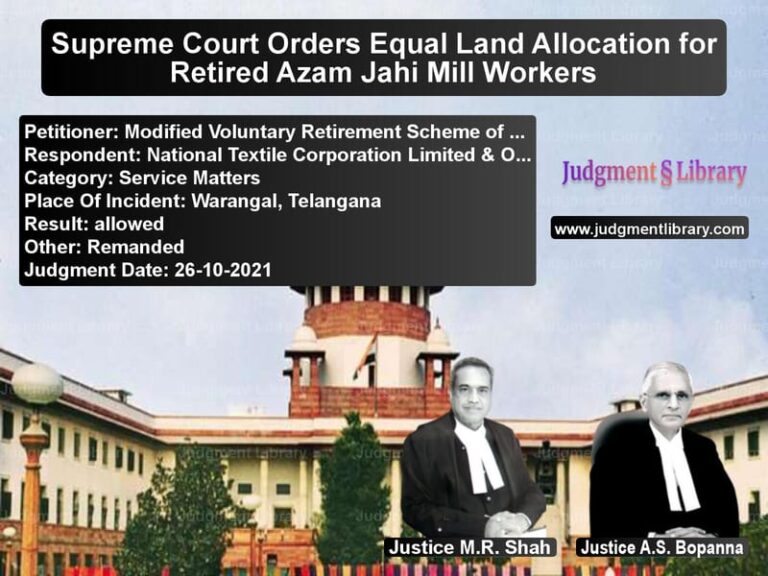Anti-Trafficking Activists vs Police: Supreme Court Quashes Criminal Case
Imagine working tirelessly to rescue children from bonded labor and human trafficking, only to find yourself facing criminal charges for your efforts. This was the shocking reality for two activists from Guria, a renowned organization fighting against human trafficking in Uttar Pradesh. Their story represents a classic clash between genuine social activism and overzealous prosecution, ultimately requiring the Supreme Court’s intervention to deliver justice. The case raises fundamental questions about when well-intentioned actions during rescue operations cross the line into criminal obstruction, and how courts should protect social activists from malicious prosecutions while ensuring public servants can perform their duties without interference.
The Background of the Case
Guria is a well-known and reputed organization fighting against human trafficking and commercial sexual exploitation of girls and children in the State of Uttar Pradesh. Due to its relentless efforts, a number of minor girls have been rescued from the clutches of traffickers. While the pioneering efforts of the organization received accolades at national and international levels, its foot soldiers i.e. the appellants have suffered the ignominy of being branded as “criminals” for alleged overzealousness in course of a raid to rescue bonded labour and minor children from a brick kiln at Varanasi, Uttar Pradesh.
The unfortunate saga commenced when the first appellant, a Project Coordinator at Guria submitted an application before the District Magistrate, Varanasi alleging bonded and child labourers were engaged in a brick kiln at Varanasi and prayed that the exploited labourers including children be rescued. In response to the application, Deputy District Magistrate, Varanasi ordered Assistant Labour Commissioner to take necessary action.
The Fateful Raid and Conflicting Versions
Pursuant to the directions of the Assistant Labour Commissioner, on June 6, 2014 at 10 am, one Raja Ram Dubey (the informant), Ram Avatar Sharma and Ram Lakhan Swarnkar (Labour Employment Officers), Inspector Ajit Kumar Singh of Anti Human Trafficking Force (AHTF) and two constables of Lohta Thana Varanasi proceeded to inspect the spot. The appellants also accompanied the team.
The appellants contended they found children and labourers at the brick kiln who were brought to the Police Station. At that time the owner of the brick kiln intervened and took away the labourers. First appellant submitted a faxed message disclosing these facts to the District Magistrate.
On the other hand, the informant lodged a complaint at Lohta Police Station alleging that when his team had reached Shakti Mark Brick Kiln, appellants along with others forcibly put the labourers and the children in dumpers and took them away. The appellants did not obey the instructions of the joint team and did not let them record their statements before taking away the labourers. Thereby they obstructed and hampered their discharge of official duty.
On his complaint, FIR came to be registered under Sections 186, 353 and 363 of the Indian Penal Code. On further statement of one of the labourers, namely, Om Prakash, Section 363 IPC was dropped. Statements of other witnesses were recorded and charge sheet under Sections 186 and 353 IPC came to be filed. The Magistrate took cognizance of the chargesheet which was assailed before the High Court.
The High Court’s Cryptic Order
The High Court by the impugned order refused to quash the chargesheet holding as follows: “From the perusal of the material on record and looking into the facts of the case at this stage it cannot be said that no offence is made out against the applicants. All the submission made at the bar relates to the disputed questions of fact, which cannot be adjudicated upon by this Court under Section 482, Cr.P.C. At this stage only a prima facie case is to be seen in the light of the law laid down by the Supreme Court in cases of R.P. Kapur Vs. State of Punjab, AIR 1960 SC 866, State of Hargana Vs. Bhajan Lal, 1992 SCC (Cr.) 426, State of Bihar Vs. P.P. Sharma, 1992 SCC (Cr.) 192 and lastly Zandu Pharmaceutical Works Ltd. Vs. Mohd. Saraful Haq and another (Para-10) 2005 SCC (Cr.) 283. The disputed defence of the accused cannot be considered at this stage. Moreover, the applicants have got a right of discharge under section 239, 245(2) or 227/228, Cr. P.C. as the case may be through a proper application for the said purpose and they are free to take all the submissions in the said discharge application before the trial Court.”
The Supreme Court noted that the above quoted paragraph shows the High Court did not advert either to the facts of the case or the contentions raised on behalf of the appellants. In a perfunctory manner it observed the issues involved disputed questions of fact which could not be adjudicated before the court under Section 482 Cr.PC. It also observed the appellants have right to seek discharge before the trial court.
The Supreme Court’s Critical Analysis
The Supreme Court made strong observations about the High Court’s approach: “However, prior to arriving at such finding it is the duty of the High Court to ascertain whether the uncontroverted allegations in the FIR/Chargesheet constitute an offence, or continuation of the proceeding suffers from a legal bar or is wholly vexatious and an abuse of process of law.”
The Court emphasized the seriousness of criminal proceedings: “Summoning of an accused is a serious matter which affects liberty and dignity of the individual concerned. Judicial intervention under Section 482 Cr.PC to weed out vexatious proceedings is of pivotal importance in order to protect individuals from untelling harassment and misery and to ensure unmerited prosecutions do not crowd overflowing dockets of criminal courts and yield space for deserving cases. Faced with the agony of a lame prosecution, it is of little solace to a litigant to be told that inherent powers are shut out as he is entitled to approach the trial court and pray for discharge. The inherent power of the High Court to prevent abuse of process of court is much wider in amplitude than the discharge powers and cannot be whittled down on the plea of existence of such remedy.”
Examining the Legal Ingredients
The Supreme Court undertook a detailed examination of whether the uncontroverted allegations in the chargesheet disclosed the ingredients of offences under Sections 186 and 353 IPC.
The Court explained: “Essential ingredients of offence under Section186 are as follows: (i) Obstruction of a public servant in discharge of public functions (ii) Such obstruction is done voluntarily and with the intention to prevent discharge of official duties.”
Regarding Section 353, the Court stated: “Section 353 is attracted when the following ingredients are satisfied: (i) Use of assault or criminal force on a public servant during execution of his duty. (ii) With the intention: (a) to prevent or deter discharge of such duty; or (b) as a consequence of anything done or attempted to be done in the lawful discharge of his duty.”
The Court further elaborated on the definitions: “The words force and criminal force are defined in Sections 349 and 356 IPC and ‘assault’ is defined in Section 351 of the said Code. A person is said to use force when: (i) He causes motion, change in motion or cessation of motion of another person by: (a) use of bodily power; or (b) using a substance which comes in contact of the body, wearing apparel etc or with anything which affects the other person’s senses; or (c) inducing any animal to move or change its motion or cease to move. Criminal force is defined as use of force by a person in order to commit an offence or done with the intention that such force is to cause or likely to cause injury, fear and annoyance to other person. Assault involves any gesture or preparation which is done with the intention that such gesture or preparation will cause an apprehension about use of criminal force. Use of criminal force or assault on a public servant is essential to attract Section 353 IPC.”
Application to Facts
Applying these legal principles to the facts, the Supreme Court held: “Coming to the facts of the case, uncontroverted allegations in the chargesheet do not disclose use of force or holding out threatening gestures giving rise to an apprehension of use of force towards public servant. Physical movement of the labourers would not amount to use of force far less criminal force on a public servant. Given this situation, we can safely conclude uncontroverted allegations in the chargesheet do not disclose the ingredients of offence under Section 353 IPC.”
Regarding Section 186 IPC, the Court analyzed: “It would be argued the appellants obstructed discharge of official duties by not permitting the statements of bonded labourers/children to be recorded before removing them from the site. Obstruction to a public servant must be done with the requisite mens rea i.e. to prevent the latter from discharging his official duty. Statements of labourers unequivocally show that no force was used to take them away and they were promptly released. These statements do not give an impression that such action was with the intention to impede discharge of official duty. It appears there was a genuine difference of opinion between the appellants and the officials concerned. Members of the social organization were of the impression that bonded labourers/children ought to be interrogated at a neutral place i.e. Police Station whereas the officers wanted to interrogate them at the site.”
The Court made a crucial distinction about intention: “It goes without saying the manner and mode of interrogation was to be decided by the labour officers but appellants’ endeavours were not to impede interrogation but to ensure it was conducted in a more effective manner. Such factual position denudes their action of the requisite mens rea, i.e. intention to obstruct official duty. When profile of the allegations emerging from the factual matrix of the case renders existence of mens rea patently absurd or inherently improbable, such prosecution is liable to be quashed as an abuse of process of law.”
Evidence of Malice
The Supreme Court found evidence of malicious intent against the appellants: “Malicious animus of the labour officials towards the appellants is evident from the reports annexed to the counter affidavit. Annexure CA/2 is a report of the Additional Labour Commissioner, U.P to National Commission for Protection of Child Rights regarding the incident. In the report, the Additional Commissioner had gone to the extent of alleging the appellants had offered bribes to the labourers to make false statements. Such insinuations are wholly unfounded and not borne out from the statements recorded during investigation. This hostile stance of the department fortifies our conclusion that registration of the criminal case was a product of malice and personal vendetta against the appellants.”
Procedural Illegalities
The Court identified significant procedural flaws: “Even assuming the ingredients under Section 186 are disclosed, prosecution under the said section simplicitor suffers from various insurmountable legal hurdles. Firstly, Section 186 is a non-cognizable offence and in absence of ingredients of Section 353 (cognizable offence) disclosed in the FIR, prior permission of Magistrate under Section 155 (2) Cr.PC was necessary to register FIR. No such permission was obtained rendering the registration of FIR and ensuing investigation bad in law.”
The Court identified another critical legal barrier: “Secondly, cognizance of offence under Section 186 IPC was taken on a police report in breach of Section 195 Cr.PC. Section 195, inter alia, provides no court shall take cognizance of offence under Section 186 save and except on a complaint in writing by the aggrieved public servant or his superior. In view of the aforesaid legal bar, cognizance taken of the offence under section 186 on a police report/chargesheet is impermissible in law.”
The Court rejected the argument that the police report could be treated as a complaint: “It would be argued as FIR was registered for both cognizable (section 353 IPC) and non-cognizable offences (section 186), even if Section 353 IPC is quashed, police report under Section 186 may be treated as ‘complaint’ in view of the Explanation to Section 2(d) Cr.P.C. Section 2(d) Cr.P.C. reads as follows: ‘2(d). complaint’ means any allegation made orally or in writing to a Magistrate, with a view to his taking action under this Code, that some person, whether known or unknown, has committed an offence, but does not include a police report.’ Explanation.- A report made by a police officer in a case which discloses, after investigation, the commission of a non-cognizable offence shall be deemed to be a complaint; and the police officer by whom such report is made shall be deemed to be the complainant.’ As per the explanation appended to the definition clause, a police report disclosing a non-cognizable offence (section 186 in the present case) shall be deemed to be a complaint and the police officer shall be deemed to be the complainant. Even then, the legal embargo under section 195 Cr.PC is not dispelled as the legal fiction deems the police officer and not the aggrieved public servant as the complainant.”
The Final Judgment
For all these reasons, the Supreme Court allowed the appeal and quashed the impugned prosecution. The judgment serves as an important precedent protecting social activists from malicious prosecutions while clarifying the legal requirements for offences involving obstruction of public servants. It reinforces that good faith differences in approach during rescue operations, without criminal intent or use of force, should not be criminalized.
The case highlights the delicate balance between enabling public servants to perform their duties without interference and protecting citizens, particularly social activists, from vexatious litigation. The Supreme Court’s intervention ensured that those working to rescue vulnerable children from bonded labor were not unjustly punished for their humanitarian efforts.
Petitioner Name: Umashankar Yadav & Anr.Respondent Name: State of Uttar Pradesh.Judgment By: Justice Pamidighantam Sri Narasimha, Justice Joymalya Bagchi.Place Of Incident: Varanasi, Uttar Pradesh.Judgment Date: 08-05-2025.Result: allowed.
Don’t miss out on the full details! Download the complete judgment in PDF format below and gain valuable insights instantly!
Download Judgment: umashankar-yadav-&-a-vs-state-of-uttar-prade-supreme-court-of-india-judgment-dated-08-05-2025.pdf
Directly Download Judgment: Directly download this Judgment
See all petitions in Bail and Anticipatory Bail
See all petitions in Fraud and Forgery
See all petitions in Custodial Deaths and Police Misconduct
See all petitions in Judgment by P.S. Narasimha
See all petitions in Judgment by Joymalya Bagchi
See all petitions in allowed
See all petitions in Quashed
See all petitions in supreme court of India judgments May 2025
See all petitions in 2025 judgments
See all posts in Criminal Cases Category
See all allowed petitions in Criminal Cases Category
See all Dismissed petitions in Criminal Cases Category
See all partially allowed petitions in Criminal Cases Category







